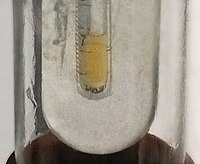
Photo from wikipedia
Abstract The pharmacokinetics, elimination, and metabolism of fostemsavir (FTR), a prodrug of the HIV-1 attachment inhibitor temsavir (TMR), were investigated in healthy volunteers. FTR was administered with and without ritonavir… Click to show full abstract
Abstract The pharmacokinetics, elimination, and metabolism of fostemsavir (FTR), a prodrug of the HIV-1 attachment inhibitor temsavir (TMR), were investigated in healthy volunteers. FTR was administered with and without ritonavir (RTV), a protease inhibitor previously shown to boost TMR exposures. In vitro studies were also used to identify the enzymes responsible for the metabolism of TMR. Total recovery of the administered dose ranged from 78% to 89%. Approximately 44% to 58% of the dose was excreted in urine, 20%–36% in faeces, and 5% in bile, as TMR and metabolites. RTV had no effect on the recovery of radioactivity in any matrix. Compared to FTR alone, pre-treatment of subjects with RTV increased the exposure of TMR by ∼66% and reduced the exposure of plasma total radioactivity by ∼68%. The major route of TMR elimination was through biotransformation. TMR, M28 (N-dealkylation), and M4 (amide hydrolysis) were the major circulating components in plasma. Pre-treatment with RTV increased the amount of TMR present, decreased the amount of circulating M28, and M4 was unchanged. CYP3A4 metabolism accounted for 21% of the dose, forming multiple oxidative metabolites. This pathway was inhibited by coadministration of RTV.
Journal Title: Xenobiotica
Year Published: 2022
Link to full text (if available)
Share on Social Media: Sign Up to like & get
recommendations!